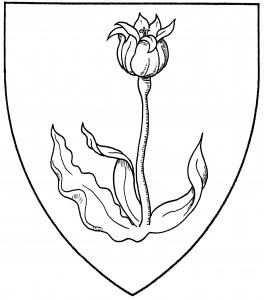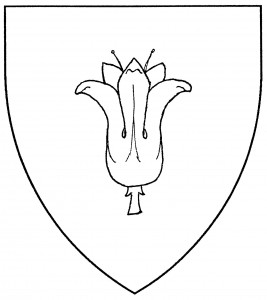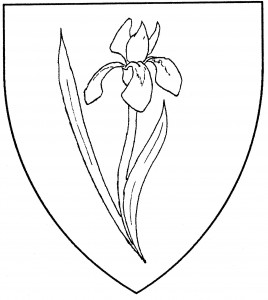Flowers are plants’ organs of reproduction, valued for their ornamental beauty or fragrance. In heraldry, flowers are generally shown affronty by default. The exceptions include such cup-shaped blossoms as the lily, such trumpet-shaped blossoms as the daffodil, and such prickly flowers as the thistle; all these are shown in profile by default. Trumpet-shaped blossoms like the daffodil must have their postures explicitly blazoned, e.g., “bell to chief”. Other exceptions are noted in the individual entries for those flowers.
For conflict purposes, the Society defines four broad categories for flowers: “few-petaled” flowers (normally shown affronty), such as the rose and the cherry blossom; “multipetaled” flowers (also normally affronty), such as the daisy and the gillyflower; “trumpet-shaped” flowers (normally shown in profile), such as the lily and the columbine; and “others”, to cover such cases as the thistle. The Society grants substantial difference between categories of flowers; within each category, no difference is granted for type of flower. (Although trumpet-shaped flowers can be granted difference for orientation.)
Any flower known to period Europeans may be used in the Society – though, if the flower is not itself European, its use may be considered a step from period practice, as with the New World dogwood. (An exception would be made for non-European flowers actually used in period European armory, but no examples have been adduced.)
Flowers may be slipped and leaved; such cases are almost always explicitly blazoned. Some flowers occur in “clusters”, with several small blossoms issuant from a single slip; these are usually so blazoned, since the individual blossoms might also be charges. A “bouquet” is a set of slipped flowers, tied or conjoined at the stems’ centers: the number of flowers is frequently specified.
For specific entries, see: columbine, daisy, edelweiss, foil, Gendy flower, gillyflower, iris, lily, lotus, rose, teazel, thistle, trillium, tulip. For related charges, see fleur-de-lys, slip, wreath.
Karol Johanna Gartenheit bears: Azure, in fess four jonquil blossoms, bells to chief Or.
Emma Dandelion bears: Vert, a dandelion slipped and leaved and a bordure argent.
Margaret Obrolchan bears: Or, three lilies of the valley vert flowered argent.
Rachel of Bon Repos bears: Argent, a hyacinth azure slipped and leaved proper.
Franca Donato bears: Argent fretty azure, on a chief sable three hibiscus blossoms argent.
Ygraine o Gaerllion Fawr bears: Purpure, a bouquet of three daffodils slipped, the centermost affronty and the outermost addorsed Or, within a bordure nebuly argent.


